

Compact Muon Solenoid
LHC, CERN
| CMS-PAS-EXO-16-003 | ||
| Inclusive search for new particles decaying to displaced jets at $\sqrt{s} = $ 13 TeV | ||
| CMS Collaboration | ||
| March 2017 | ||
| Abstract: A search for long-lived particles was performed with data corresponding to an integrated luminosity of 2.6 fb$^{-1}$ collected at a center-of-mass energy of 13 TeV by the CMS experiment in 2015. The analysis exploits two customized topological trigger algorithms and an offline displaced-jet tagging algorithm. The multiplicity of displaced jets is used to search for the presence of a signal with a proper lifetime between 1 mm and 1000 mm. Pair-produced long-lived decays to four jet final states, with cross sections larger than 1.2 fb are excluded for a proper lifetime of 50 mm. For pair-produced long-lived decays to two b quarks and two leptons with equal decay rates between lepton flavors, cross sections larger than 2.5 fb are excluded for proper lifetimes between 70 mm and 100 mm. As a mass exclusion bound, pair-produced long-lived R-parity violating top squarks lighter than 550-1130 GeV are excluded depending on their lifetime and decay mode. This mass exclusion bound is currently the most stringent bound available for top squark proper lifetimes greater than 3 mm. | ||
|
Links:
CDS record (PDF) ;
inSPIRE record ;
CADI line (restricted) ;
These preliminary results are superseded in this paper, PLB 780 (2018) 432. The superseded preliminary plots can be found here. |
||
| Figures | |

png pdf |
Figure 1:
Comparison of MC and data distributions for the displaced-jet tagging variables $\alpha _{\textrm {max}}$ (left), $\hat{IP}^{\textrm {2D}}_{\textrm {sig}}$ (center), and $\hat{\Theta}_{\textrm {2D}}$ (right). The data distributions (circles) are compared to the expected background distributions from multijet events (squares) and several Jet-Jet benchmark models (dotted histograms) of pair-produced long-lived neutral scalar particles with $m_{X} = $ 700 GeV and different values of $c\tau _0$. The vertical lines designate the value of requirement for the nominal displaced-jet tag. The direction of the arrow indicates the values included in the requirement. All distributions have unit normalization. |

png pdf |
Figure 1-a:
Comparison of MC and data distributions for the displaced-jet tagging variables $\alpha _{\textrm {max}}$. The data distributions (circles) are compared to the expected background distributions from multijet events (squares) and several Jet-Jet benchmark models (dotted histograms) of pair-produced long-lived neutral scalar particles with $m_{X} = $ 700 GeV and different values of $c\tau _0$. The vertical lines designate the value of requirement for the nominal displaced-jet tag. The direction of the arrow indicates the values included in the requirement. All distributions have unit normalization. |
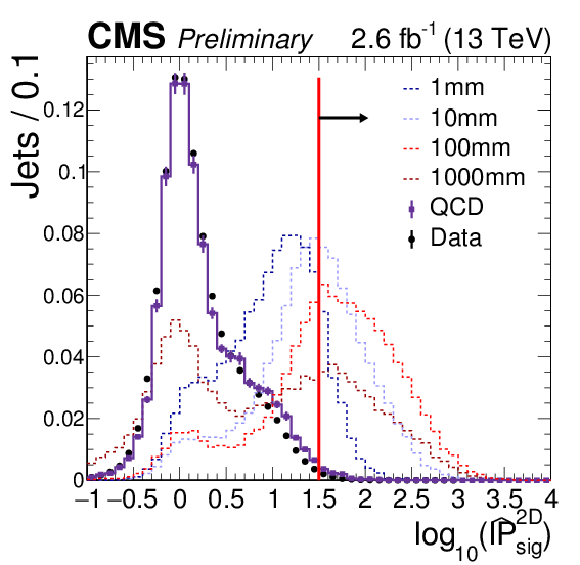
png pdf |
Figure 1-b:
Comparison of MC and data distributions for the displaced-jet tagging variables $\hat{IP}^{\textrm {2D}}_{\textrm {sig}}$. The data distributions (circles) are compared to the expected background distributions from multijet events (squares) and several Jet-Jet benchmark models (dotted histograms) of pair-produced long-lived neutral scalar particles with $m_{X} = $ 700 GeV and different values of $c\tau _0$. The vertical lines designate the value of requirement for the nominal displaced-jet tag. The direction of the arrow indicates the values included in the requirement. All distributions have unit normalization. |
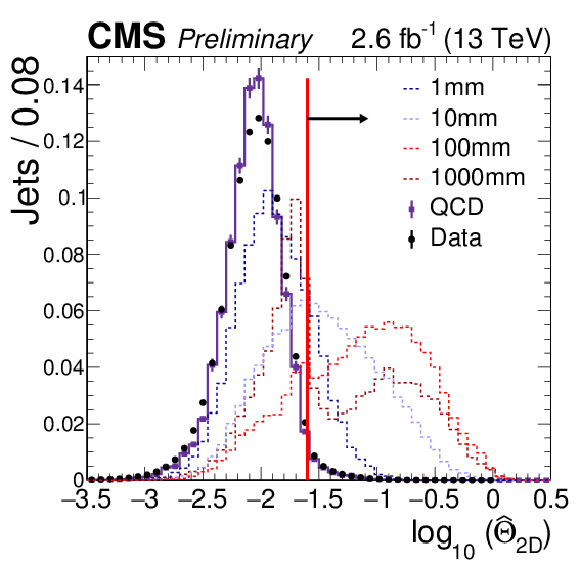
png pdf |
Figure 1-c:
Comparison of MC and data distributions for the displaced-jet tagging variables $\hat{\Theta}_{\textrm {2D}}$. The data distributions (circles) are compared to the expected background distributions from multijet events (squares) and several Jet-Jet benchmark models (dotted histograms) of pair-produced long-lived neutral scalar particles with $m_{X} = $ 700 GeV and different values of $c\tau _0$. The vertical lines designate the value of requirement for the nominal displaced-jet tag. The direction of the arrow indicates the values included in the requirement. All distributions have unit normalization. |

png pdf |
Figure 2:
The fraction of jets passing the displaced-jet tagging criteria as a function of the number tracks associated with the jet. The results are from data events with $N_{\textrm {tags}} \leq $ 1 collected with the displaced-jet triggers and passing the offline selection criteria. |
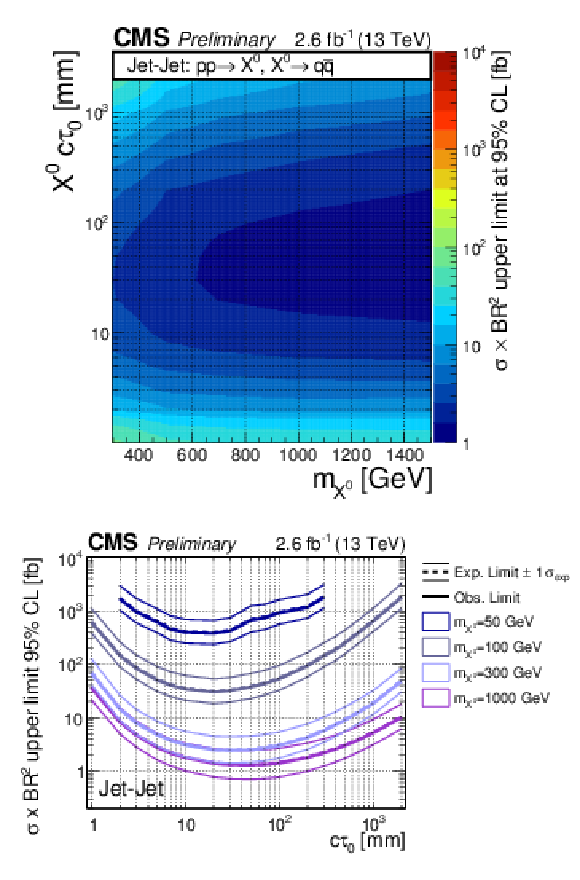
png pdf |
Figure 3:
The excluded cross section at 95% CL for the Jet-Jet model as a function of the mass and proper lifetime of the parent particle $X^0$ (top) and as a function of the proper lifetime for four values of the mass (bottom). The bottom plot also shows the expected upper limits with one standard deviation uncertainties. |
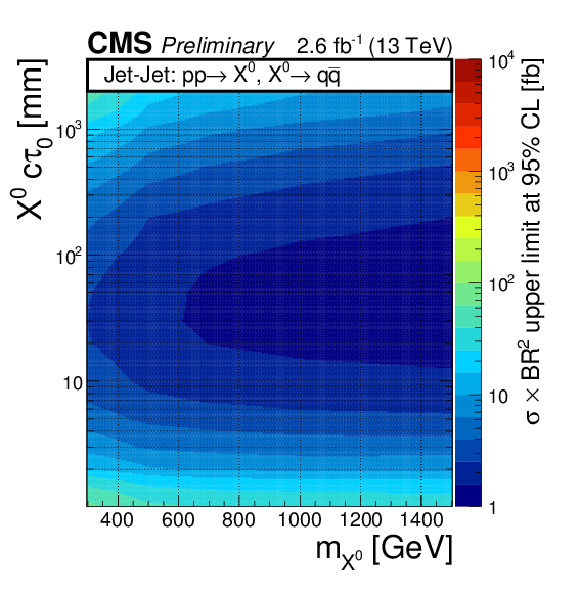
png pdf |
Figure 3-a:
The excluded cross section at 95% CL for the Jet-Jet model as a function of the mass and proper lifetime of the parent particle $X^0$. |

png pdf |
Figure 3-b:
The excluded cross section at 95% CL for the Jet-Jet model as a function of the proper lifetime for four values of the mass. The plot also shows the expected upper limits with one standard deviation uncertainties. |
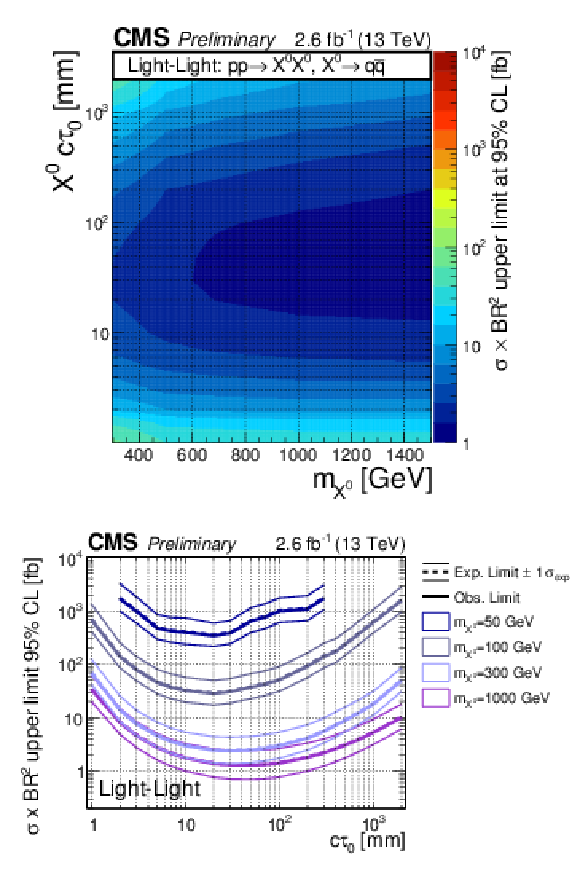
png pdf |
Figure 4:
The excluded cross section at 95% CL for the Light-Light model as a function of the mass and proper lifetime of the parent particle $X^0$ (top) and as a function of the proper lifetime for four values of the mass (bottom). The bottom plot also shows the expected upper limits with one standard deviation uncertainties. |
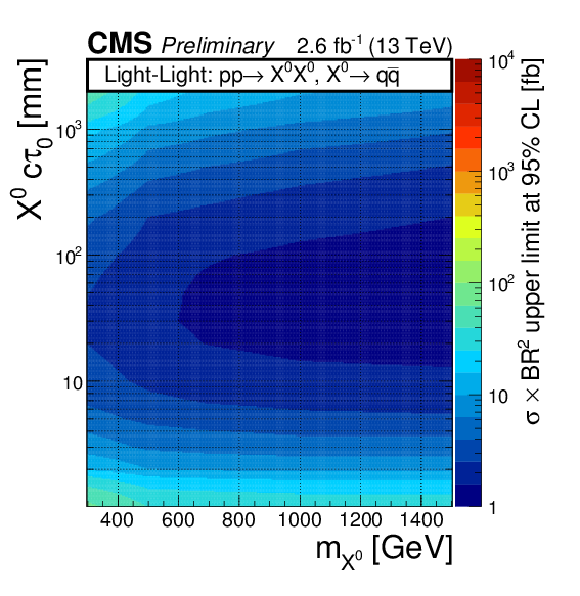
png pdf |
Figure 4-a:
The excluded cross section at 95% CL for the Light-Light model as a function of the mass and proper lifetime of the parent particle $X^0$. Figure 4-b |
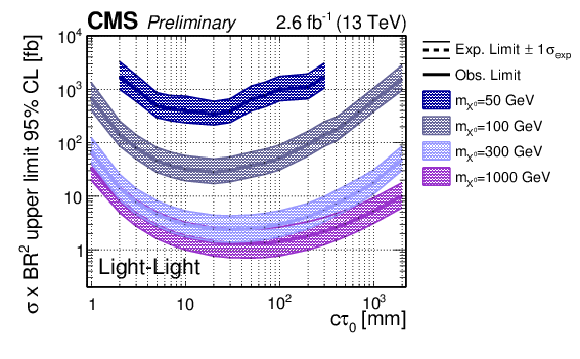
png pdf |
Figure 4-b:
The excluded cross section at 95% CL for the Light-Light model as a function of the mass and proper lifetime of the parent particle $X^0$ (top) and as a function of the proper lifetime for four values of the mass (bottom). The bottom plot also shows the expected upper limits with one standard deviation uncertainties. |
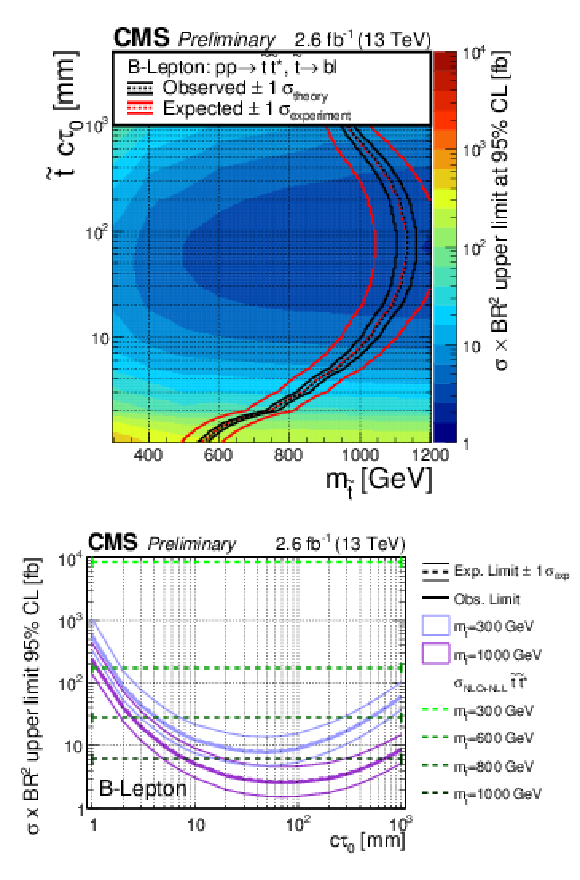
png pdf |
Figure 5:
The excluded cross section at 95% CL for the B-Lepton model as a function of the mass and proper lifetime of the parent particle $\tilde{ \mathrm{ t } } $ (top) and as a function of the proper lifetime for two values of the mass (bottom). The top plot also shows the expected (observed) exclusion region with one standard deviation experimental (theoretical) uncertainties, utilizing a NLO+NLL calculation of the top squark production cross section. The bottom plot also shows the expected upper limits with one standard deviation uncertainties and the NLO+NLL calculation of the top squark production cross section at two mass values. |

png pdf |
Figure 5-a:
The excluded cross section at 95% CL for the B-Lepton model as a function of the mass and proper lifetime of the parent particle $\tilde{ \mathrm{ t } } $. The plot also shows the expected (observed) exclusion region with one standard deviation experimental (theoretical) uncertainties, utilizing a NLO+NLL calculation of the top squark production cross section. |

png pdf |
Figure 5-b:
The excluded cross section at 95% CL for the B-Lepton model as a function of the proper lifetime for two values of the mass. The plot also shows the expected upper limits with one standard deviation uncertainties and the NLO+NLL calculation of the top squark production cross section at two mass values. |
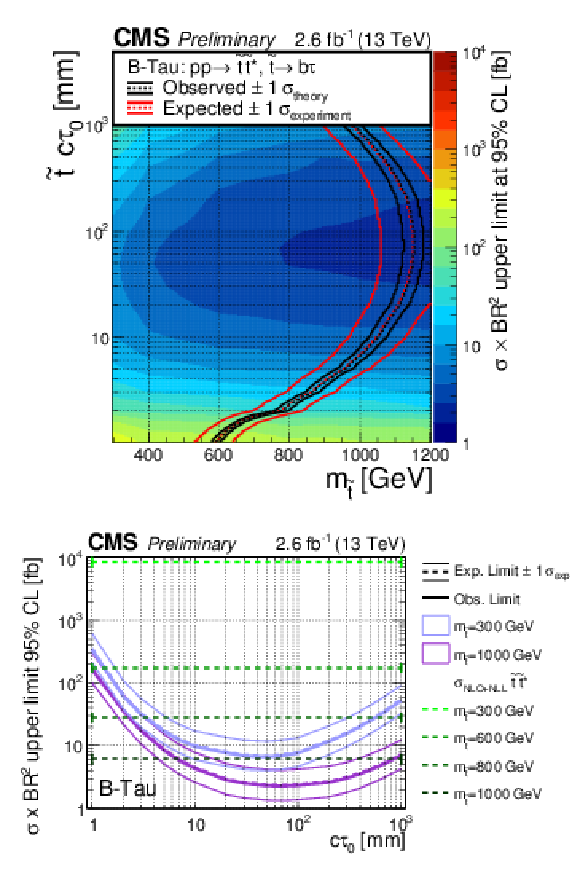
png pdf |
Figure 6:
The excluded cross section at 95% CL for the B-Tau model as a function of the mass and proper lifetime of the parent particle $\tilde{ \mathrm{ t } } $ (top) and as a function of the proper lifetime for two values of the mass (bottom). The top plot also shows the expected (observed) exclusion region with one standard deviation experimental (theoretical) uncertainties, utilizing a NLO+NLL calculation of the top squark production cross section. The bottom plot also shows the expected upper limits with one standard deviation uncertainties and the NLO+NLL calculation of the top squark production cross section at two mass values. |
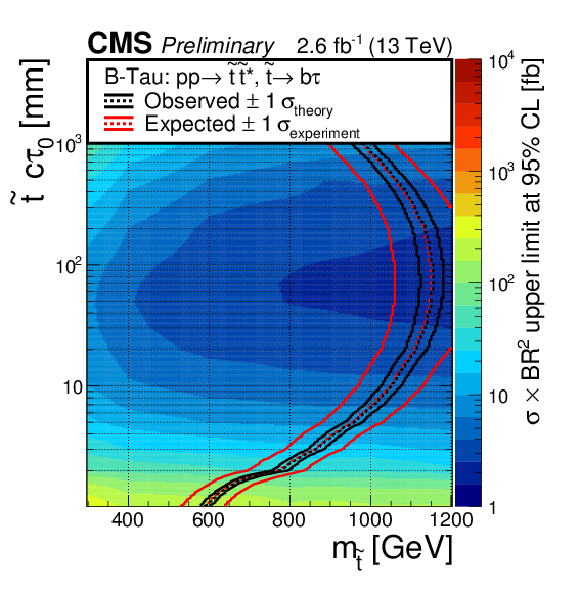
png pdf |
Figure 6-a:
The excluded cross section at 95% CL for the B-Tau model as a function of the mass and proper lifetime of the parent particle $\tilde{ \mathrm{ t } } $. The plot also shows the expected (observed) exclusion region with one standard deviation experimental (theoretical) uncertainties, utilizing a NLO+NLL calculation of the top squark production cross section. |

png pdf |
Figure 6-b:
The excluded cross section at 95% CL for the B-Tau model as a function of the proper lifetime for two values of the mass. The plot also shows the expected upper limits with one standard deviation uncertainties and the NLO+NLL calculation of the top squark production cross section at two mass values. |

png pdf |
Figure 7:
The excluded cross section at 95% CL for the B-Ele model as a function of the mass and proper lifetime of the parent particle $\tilde{ \mathrm{ t } } $ (top) and as a function of the proper lifetime for two values of the mass (bottom). The top plot also shows the expected (observed) exclusion region with one standard deviation experimental (theoretical) uncertainties, utilizing a NLO+NLL calculation of the top squark production cross section. The bottom plot also shows the expected upper limits with one standard deviation uncertainties and the NLO+NLL calculation of the top squark production cross section at two mass values. |

png pdf |
Figure 7-a:
The excluded cross section at 95% CL for the B-Ele model as a function of the mass and proper lifetime of the parent particle $\tilde{ \mathrm{ t } } $. The plot also shows the expected (observed) exclusion region with one standard deviation experimental (theoretical) uncertainties, utilizing a NLO+NLL calculation of the top squark production cross section. |

png pdf |
Figure 7-b:
The excluded cross section at 95% CL for the B-Ele model as a function of the proper lifetime for two values of the mass. The plot also shows the expected upper limits with one standard deviation uncertainties and the NLO+NLL calculation of the top squark production cross section at two mass values. |
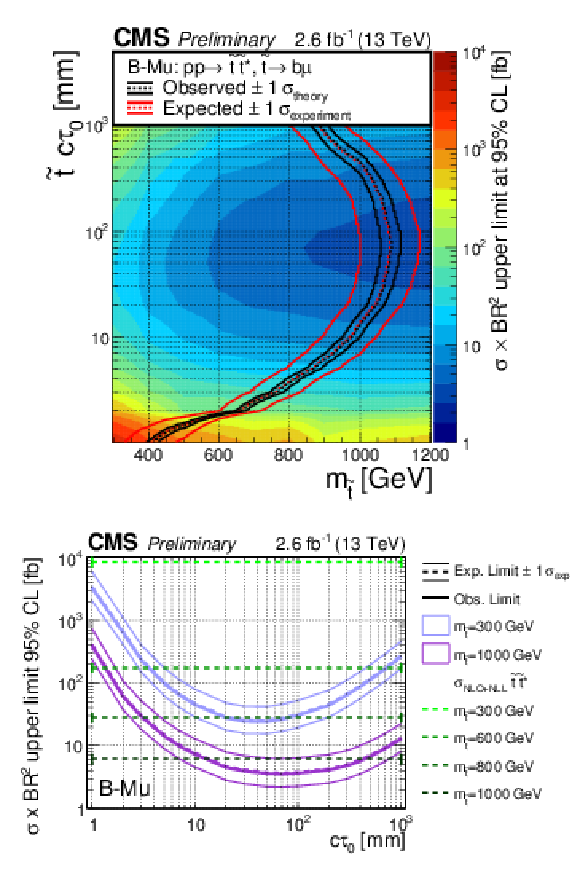
png pdf |
Figure 8:
The excluded cross section at 95% CL for the B-Mu model as a function of the mass and proper lifetime of the parent particle $\tilde{ \mathrm{ t } } $ (top) and as a function of the proper lifetime for two values of the mass (bottom). The top plot also shows the expected (observed) exclusion region with one standard deviation experimental (theoretical) uncertainties, utilizing a NLO+NLL calculation of the top squark production cross section. The bottom plot also shows the expected upper limits with one standard deviation uncertainties and the NLO+NLL calculation of the top squark production cross section at two mass values. |

png pdf |
Figure 8-a:
The excluded cross section at 95% CL for the B-Mu model as a function of the mass and proper lifetime of the parent particle $\tilde{ \mathrm{ t } } $. The plot also shows the expected (observed) exclusion region with one standard deviation experimental (theoretical) uncertainties, utilizing a NLO+NLL calculation of the top squark production cross section. |
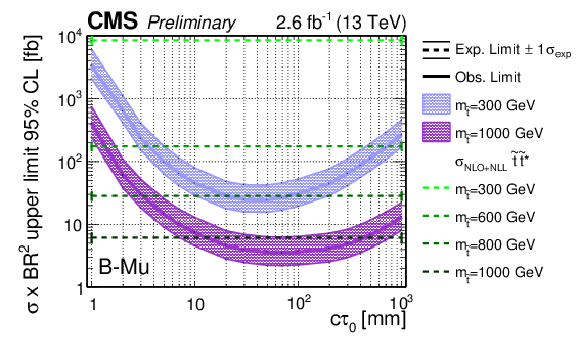
png pdf |
Figure 8-b:
The excluded cross section at 95% CL for the B-Mu model as a function of the proper lifetime for two values of the mass. The plot also shows the expected upper limits with one standard deviation uncertainties and the NLO+NLL calculation of the top squark production cross section at two mass values. |
| Tables | |
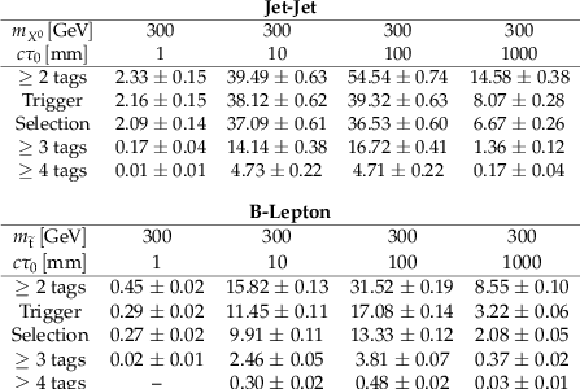
png pdf |
Table 1:
Signal efficiencies (in %) for $m_{X^0}=m_{\tilde{ \mathrm{ t } } }=$ 300 GeV and varied $c\tau _0$ for the Jet-Jet and B-Lepton models. Selection requirements are cumulative from the first to the last row. |
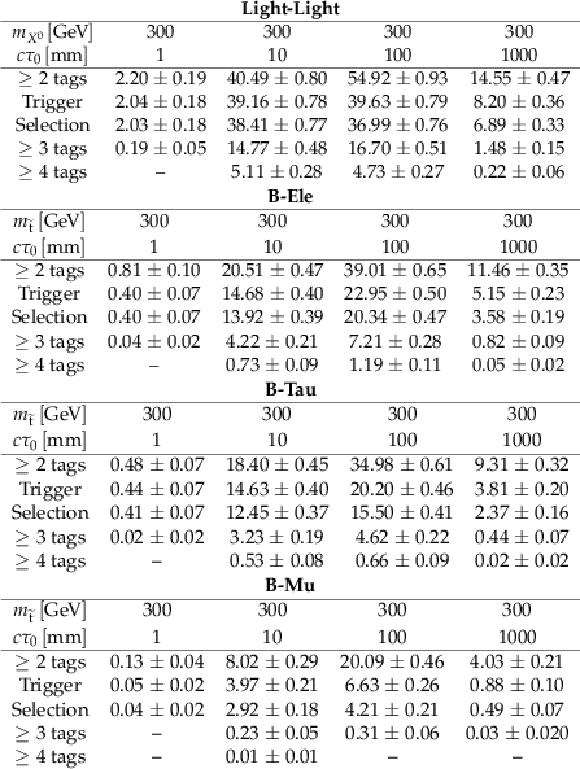
png pdf |
Table 2:
Signal efficiencies (in %) for $m_{X^0}=m_{\tilde{ \mathrm{ t } } }=$ 300 GeV and varied $c\tau _0$ with modified branching ratios relative to the Jet-Jet and B-Lepton models. Selection requirements are cumulative from the first to the last row. |
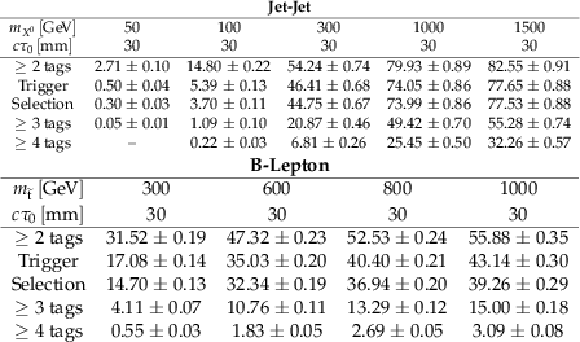
png pdf |
Table 3:
Signal efficiencies (in %) for the Jet-Jet and B-Lepton models with $c\tau _0=$ 30 mm and varied mass. Selection requirements are cumulative from the first to the last row. |
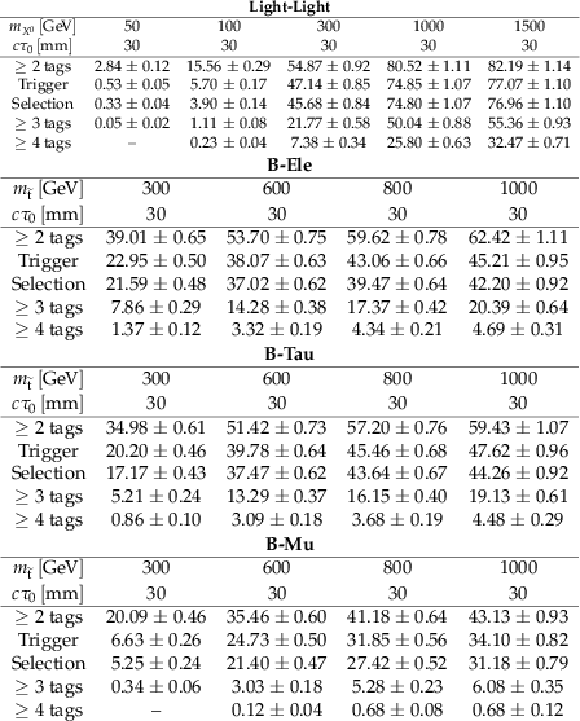
png pdf |
Table 4:
Signal efficiencies (in %) for $c\tau _0=$ 30 mm and varied mass with modified branching ratios relative to the Jet-Jet and B-Lepton models. Selection requirements are cumulative from the first to the last row. |
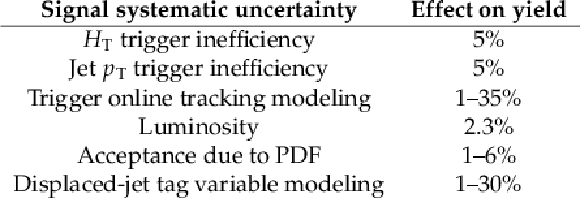
png pdf |
Table 5:
Summary of the signal systematic uncertainties. When the uncertainty depends on the specific features of the models (mass, lifetime and decay mode of the long-lived particle) a range is quoted, which refers to the computed uncertainty for $N_{\textrm {tags}}=$ 2 events. |

png pdf |
Table 6:
The predicted and observed number of events as a function of $N_{\textrm {tags}}$. The prediction is based on the misidentification rate derived from events with fewer than two tags. The full event selection is applied. The uncertainty corresponds to the total background systematic uncertainty. |
| Summary |
| A search for long-lived particles was performed with data corresponding to an integrated luminosity of 2.6 fb$^{-1}$ collected at a center-of-mass energy of 13 TeV by the CMS experiment in 2015. This is the first search made for long-lived decays to jet final states in 13 TeV data and the first search to demonstrate explicit sensitivity to long-lived decays to tau leptons. The analysis utilized two customized topological trigger algorithms and an offline displaced-jet tagging algorithm, with the multiplicity of displaced jets used to search for the presence of a signal. As no excess above the predicted background is found, upper limits are set at 95% confidence level on the production cross section for resonances decaying to two jets or to a lepton and b quark. The limits are calculated as a function of the mass and proper lifetime of the long-lived particles. For the jet-jet (bottom-lepton) decay mode, cross sections larger than 1.2 fb (2.5 fb) are excluded for proper lifetimes of 50 mm (70-100 mm). The cross section limits are also translated into mass exclusion bounds, using a calculation of the top squark production cross section as a reference. Pair-produced long-lived R-parity violating top squarks lighter than 550-1130 GeV are excluded, depending on their lifetime and decay mode. This mass exclusion bound is currently the most stringent bound available for top squark proper lifetimes greater than 3 mm. |
| References | ||||
| 1 | ATLAS Collaboration | Search for long-lived, weakly interacting particles that decay to displaced hadronic jets in proton-proton collisions at $ \sqrt{s}= $ 8 TeV with the ATLAS detector | PRD 92 (2015) 012010 | 1504.03634 |
| 2 | ATLAS Collaboration | Search for massive, long-lived particles using multitrack displaced vertices or displaced lepton pairs in pp collisions at $ \sqrt{s} $ = 8 TeV with the ATLAS detector | PRD 92 (2015) 072004 | 1504.05162 |
| 3 | CMS Collaboration | Search for Long-Lived Neutral Particles Decaying to Quark-Antiquark Pairs in Proton-Proton Collisions at $ \sqrt{s} = $ 8 TeV | PRD 91 (2015) 012007 | CMS-EXO-12-038 1411.6530 |
| 4 | T. Sjostrand, S. Mrenna, and P. Z. Skands | A brief introduction to PYTHIA 8.1 | CPC 178 (2008) 852 | 0710.3820 |
| 5 | R. Ball et al. | Parton distributions with LHC data | Nucl. Phys. B 867 (2013) 244 | 1207.1303 |
| 6 | M. Strassler and K. Zurek | Discovering the Higgs through highly-displaced vertices | PLB 263 (2008) 2 | |
| 7 | P. W. Graham, D. E. Kaplan, S. Rajendran, and P. Saraswat | Displaced Supersymmetry | JHEP 07 (2012) 149 | 1204.6038 |
| 8 | CMS Collaboration | Description and performance of track and primary-vertex reconstruction with the CMS tracker | JINST 9 (2014) P10009 | CMS-TRK-11-001 1405.6569 |
| 9 | CMS Collaboration | CMS Luminosity Measurement for the 2015 Data Taking Period | CMS-PAS-LUM-15-001 | CMS-PAS-LUM-15-001 |
| 10 | A. L. Read | Presentation of search results: the $ CL_s $ technique | JPG 28 (2002) 2693 | |
| 11 | T. Junk | Confidence level computation for combining searches with small statistics | NIMA 434 (1999) 435 | hep-ex/9902006 |
| 12 | CMS and ATLAS Collaborations | Procedure for the LHC Higgs boson search combination in Summer 2011 | CMS-NOTE-2011-005 | |
| 13 | W. Beenakker, R. Hopker, M. Spira, and P. M. Zerwas | Squark and gluino production at hadron colliders | Nucl. Phys. B 492 (1997) 51 | hep-ph/9610490 |
| 14 | A. Kulesza and L. Motyka | Threshold resummation for squark-antisquark and gluino-pair production at the LHC | PRL 102 (2009) 111802 | 0807.2405 |
| 15 | A. Kulesza and L. Motyka | Soft gluon resummation for the production of gluino-gluino and squark-antisquark pairs at the LHC | PRD 80 (2009) 095004 | 0905.4749 |
| 16 | W. Beenakker et al. | Soft-gluon resummation for squark and gluino hadroproduction | JHEP 12 (2009) 041 | 0909.4418 |
| 17 | W. Beenakker et al. | Squark and gluino hadroproduction | Int. J. Mod. Phys. A 26 (2011) 2637 | 1105.1110 |
| 18 | M. Kramer et al. | Supersymmetry production cross sections in pp collisions at $ \sqrt{s}= $ 7 TeV | 1206.2892 | |

|
Compact Muon Solenoid LHC, CERN |

|

|

|

|

|

|